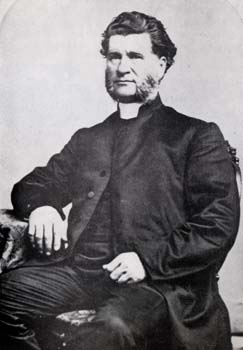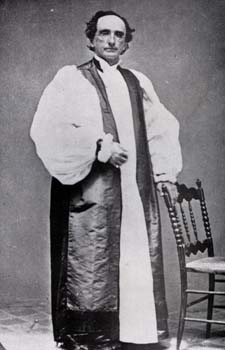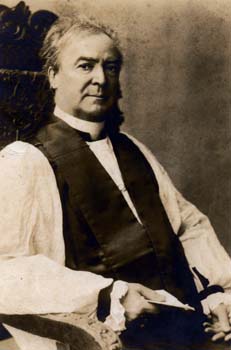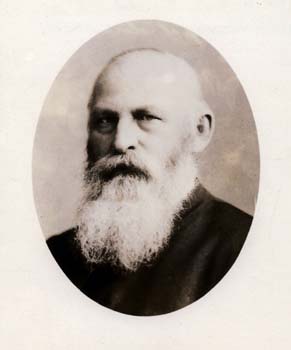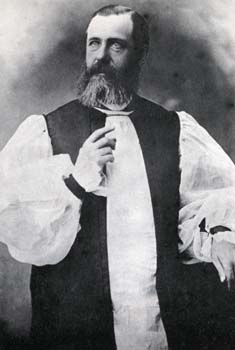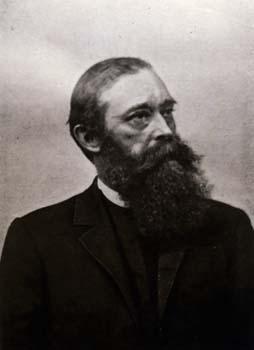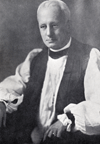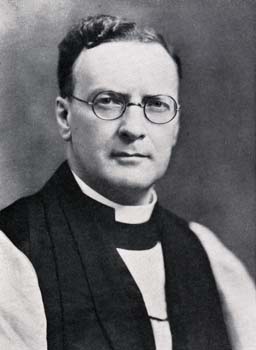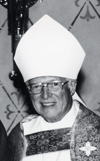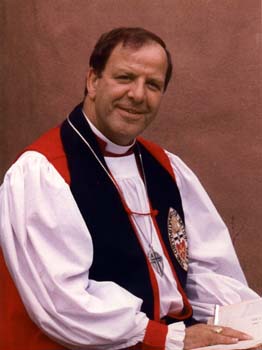Bishops serving the New Mexico District/Diocese:
Joseph C. Talbot (1863-1866)
George M. Randall (1866-1873)
William F. Adams (1875-1875)
John F. Spalding (1876-1880)
George Kelly Dunlop (1880-1888)
John Mills Kendrick (1889-1911)
Cameron Mann (1912-1913)
Frederick B. Howden (1914-1940)
Frederick B. Bartlett (1941-1941)
James Moss Stoney (1942-1956)
Charles James Kinsolving III (Co-Adjutor 1953-1956 Bishop 1956-1972)
Richard M. Trelease Jr. (1971-1987)
William Davidson (1988-1988)
Terence Kelshaw (1989-2004)
Jeffrey Steenson (2005-2007)
William Frey (2008-2018) [Overseerer]
Michael Vono (2010-2018)
Michael Buerkel Hunn (2018-present)
Joseph Cruickshank Talbot (1863-1866) overseer
Born in Alexandria, Virginia, September 5, 1816, and educated at Pierpont Academy, Alexandria. Moved to Louisville, Kentucky, in 1835, where he was engaged in business for several years. Baptized in Christ Church, Louisville in 1837, and was confirmed by the Bishop of Kentucky the same year. In 1841 he became a candidate for Holy Orders, and studied under the Bishop's direction. He was ordered deacon in Christ Church, Louisville, September 5, 1846, by the Rt. Rev. Benjamin B. Smith, and ordered Priest by Bishop Smith at Christ Church, September 6, 1848. While in deacon's orders, he organized St. John's Church, Louisville, and became its rector when advanced to the priesthood. In 1853, he moved to Indiana and became the rector of Christ Church, Indianapolis. In 1859, he was elected by the House of Bishops as Bishop of the Diocese of the Northwest, a new jurisdition, including Nebraska, the Dakotas, Wyoming, Colorado, New Mexico, Arizona, Utah, Montana and Idaho, an area of about 900,000 square miles. He was consecrated in Christ Church, Indianapolis, February 15, 1860. In 1865, he was elected Assistant Bishop of Indiana, and was translated in October of that year. He became diocesan in 1872.
He visited New Mexico briefly in the summer of 1863 when it was part of a vast jurisdiction, stretching from Canada to Mexico, known as the Diocese of the Northwest. The bishop made stops at Ft. Union near Las Vegas, Santa Fe (where he held services and celebrated what was reportedly the first Episcopal Communion Service in the territory) and Taos. Of particular interest was Talbot's contact with Padre Jose' Antonio Martinez, defrocked by Roman Catholic Bishop Lamy for setting up a chapel and services of his own - using the Episcopal Prayer Book, recently published in Spanish. Talbot's departure left the area north of El Paso without permanent oversight for another seventeen years. He died on January 15, 1883, in Indianapolis.
George M. Randall (1866-1873) overseer
George M. Randall, by 1868 Bishop of the District of Wyoming, Colorado and New Mexico, visited Cimarron, Santa Fe and Mesilla, NM, in 1872. Bishop Randall preached in the small Mesilla Grace Chapel both morning and evening on Sunday, June 16, and held an afternoon service in Las Cruces, NM before returning to Colorado, by way of Santa Fe, on a journey of 700 miles.
William F. Adams (1875-1875) elected
William Forbes Adams, of a flourishing city parish in New Orleans, who was elected in 1874 to serve Arizona and New Mexico, came west with his Chaplain, Henry Forrester. Adams lacked the stamina required for such rigorous trips by stage coach, became ill before reaching Santa Fe and never fully recovered. He officiated at services there, in Albuquerque, Ft. Seldon, Mesilla Park and Silver City. Although Arizona was on his itinerary, an urgent appeal from his wife in New Orleans for help with an ill child tempted Adams to go back to her directly through Texas without even returning to Santa Fe. On doctor's advice, Adams resigned that same summer of 1875. His remains the shortest term of office of any bishop to serve New Mexico, but he left a grand legacy in the person of Henry Forrester who continued to serve as Missioner throughout the southwest and Mexico. Adams died in 1920. The General Convention of 1877 elected DB Knickerbocker of Minnesota, but he declined, and the episcopal responsibility for the territory eventually fell to Bishop Spalding of Colorado.
John Franklin Spalding (1876-1880) overseer
The second Missionary Bishop of Colorado with jurisdiction in the territories of Wyoming and New Mexico, was born in Belgrade, Maine, on August 25, 1828. He graduated from Bowdoin College, Brunswick, Maine, in 1853, and from the General Theological Seminary, New York, in 1857. He was ordered deacon in St. Stephen's Church, Portland, on July 14,1858, by the Rt. Rev. George Burgess. For two years he was missionary at St. James' Church, Oldtown, Maine, and rector of St. George's Church, Lee, Massachusetts, from August 1, 1859, until November 1, 1860. He was assistant minister at Grace Church, Providence, Rhode Island, from November 1, 1860, to November 1, 1861. He then officiated for several months in St. John's Church, Providence, and in April, 1862, became rector of St. Paul's Church, Erie, Pennslyvania, where he remained until elected bishop. He was consecrated Missionary Bishop of Colorado with jurisdiction in Wyoming and New Mexico in St. Paul's Church, Erie, on December 31, 1873. His conscecrators were the Rt. Rev. Samuel A. McCrosky, assisted by the Rt. Rev. Gregory Thurston Bedell, the Rt. Rev. Joseph Cruickshank Talbot, the Rt. Rev. Arthur Cleveland Coxe, and the Rt. Rev. John Barrett Kerfoot. Bishop Spalding died in 1902.
George Kelly Dunlop (1880-1888) elected
George Kelly Dunlop was born in County Tyrone, Ireland, November 10, 1830, the son of Robert and Margaret Kelly Dunlop, both parents being of Scottish descent. He was educated at the Royal College of Dungannon and at the Queen's University at Galway from which he was graduated in 1852. He was a brilliant student, ranking second among eight students who won classical scholarships. Immediately following his graduation he came to the United States and for two years taught in the academy at St. Joseph, Missouri. In December, 1854, he was ordained Deacon by Bishop Hawks of the Diocese of Missouri and for two years served in that capacity at Trinity Church in St. Charles. In 1856 he was ordained Priest, again by Bishop Hawks, and went to Lexington, Missouri, where he remained for seven years.
On July 23, 1857, he married Miss Mary Wickham Cobb. He became Temporary Rector of Grace Church, Kirkwood, September 25, 1864, and on May 23rd of the following year, Permanent Rector. He held this position until 1880 when the General Convention of the Episcopal Church elected him to fill the vacant episcopate of Missionary Bishop of the Territories of Arizona and New Mexico. This was brought about by Bishop Robertson of Missouri who, on the way to the convention that year happened to mention that Mr. Dunlop should by rights be a missionary bishop and then proceeded to recommend him to the convention. By doing so he deprived himself and his diocese of the services of one of his ablest ministers but he also helped to establish the church on a firm foundation in that vast and wild southwest territory.
In the History of New Mexico, Volume 1, published by Pacific States Publishing Company in 1907 this statement appears, "There seems to be no doubt that the first permanent religious organization, aside from the Roman Catholic Church, in New Mexico was effected by the missionaries of the Protestant Episcopal Church."
The first visit of an Episcopal minister to that territory, of which there is official record, was made by the Reverend Joseph Cruikshank Talbot who was at that time Missionary Bishop of the Northwest. On July 5, 1863 - so the records show - he acted as Chaplain to a Fourth of July procession and on the following day - a Sunday - he preached in the Presbyterian Church in Santa Fe and administered Holy Communion for the first time in New Mexico to five persons besides the clergy.
For the next few years various clergymen conducted services whenever they could and in 1874 the General Convention of the Church created the Missionary District of New Mexico and Arizona. In the six years that followed a number of Bishops were appointed, none of whom remained long because of the danger, difficulties, and arduous work.
Mr. Dunlop was of a different calibre. Thoroughly aware of what he was getting into - of the hardships his family would have to endure, of the dangers he would encounter in traveling about the territory under his care, of the vast amount of work and energy it would take to accomplish what he was setting out to do - he accepted the appointment.
He assumed his duties as Missionary Bishop on March 21, 1881. Nothing seemed to daunt him, no distance too far to travel, no difficulties too great to overcome, no weather too severe to stop him. He traveled over all of New Mexico and Arizona in carts, on horseback, and on foot in all kinds of weather, summer and winter, in the face of hostile Indians, a great financial depression and with practically no church facilities or property. Yet when he died seven years later in 1888 a beautiful stone church had been built in Santa Fe, one in Albuquerque, an adobe church and rectory in Tombstone, St. Paul's Church and Rectory in Las Vegas, and building lots had been acquired in Tucson, Raton and numerous other places.
When death came to him, of pneumonia, on March 12, 1888, exhaustion was a contributory cause. A man of tremendous energy and capacity for work, he was in the truest sense a missionary bishop, never content to settle in one place for long, eager always to be on the move, getting a church started in one locality, then moving on to another. At the time of his election as Bishop, he had outgrown Missouri. It took the great Southwest to furnish space for him to work out his aims and ambitions.
Mourned by all who knew him, he was buried in St. Paul's Church in Las Vegas, New Mexico. The magnificent altar there, of white Italian marble, with columns of polished Mexican onyx, was given in his memory by the Woman's Auxiliary of the Diocese of Missouri. Other memorials in St. Paul's are the "bishop's chair" and a "robing room."
Grace Church, Kirkwood, also has a memorial to its first Rector. The beautifully carved oak altar was placed in the church in 1891 by the "Ladies of the Parish" and was consecrated by the Reverend Daniel S. Tuttle, then Bishop of Missouri.
Memory of this remarkable man lingered long in the minds of the members of Grace Church. The men remembered him chiefly for the winter hours they, as youths, had spent with him while he taught them Latin and Greek and for the summer outings when he had taken them to the Meramec River and taught them to swim. The women remembered him for his sweetness and tenderness toward his invalid wife. All remembered him for his never failing flow of wit and humor, his bright blue eyes and his sunny smile.
John Mills Kendrick (1889-1911) elected
John Mills Kendrick was born in Gambier, Ohio, on May 14, 1836. He was educated at Marietta College and also the Theological School in Gambier. After graduating from Marietta College in 1856, he entered upon the study of law. He was admitted to the bar in New York state, but shortly thereafter he turned toward a religious vocation, entering the Theological School at Marietta, Ohio. At the outbreak of the Civil War he left the seminary, serving in the Union forces, first as a private finishing his service, later as an assistant adjutant-general. In 1864 he was ordained to the deaconate. He served the Protestant Episcopal Church in Kansas, and later in Ohio as assistant minister of Trinity Church, Columbus, after his ordination in June, 1865. From 1878 until the time of his consecration as the third Bishop of New Mexico and Arizona, he served as diocesan general missionary. In 1888 he received his doctorate in divinity from Marietta. He was consecrated as Bishop in Trinity Church, Columbus, Ohio, on January 18, 1889. Kendrick's assignment, the district of New Mexico, Arizona and a portion of Texas, 236,313 square miles of territory, was one of the most difficult for any Bishop of the Episcopal Church. Kendrick settled first in Las Vegas, New Mexico, then moved to Albuquerque. He later moved his headquarters to El Paso, Texas. He maintained a winter residence in Phoenix and a summer home in Oceanside, California, where he died on December 16, 1911, after twenty-three years of service in the Southwest. Kendrick's papers, sermons and correspondence are available upon request.
Cameron Mann (1912-1913) overseer
Bishop Mann was given oversight of the District of New Mexico and Texas West of the Pecos in 1911, after the death of Bishop Kendrick. Born April 13, 1851, in New York City. Graduated from the General Theological Seminary and was ordained deacon in 1873, and was advanced to the priesthood in 1876 by Bishop Coxe of Western New York. His first rectorships were at Branchport and Dresden, New York. In 1875 he became curate at St. Peter's, Albany, and in 1882, moved to Grace Church, Kansas City. December 4, 1901, consecrated Bishop of the Missionary District of North Dakota. He had little influence in New Mexico and Texas West of the Pecos, and in 1913 was transferred to the Missionary District of South Florida. He died at Winter Park, Florida, February 8, 1932.
Frederick Bingham Howden (1914-1940) elected
Rt. Rev. Frederick Bingham Howden was born in West Brighton, Staten Island, New York, on December 10,1869, to William Douglas Howden and Ester Jane (Orrell). Received a B.A. at Trinity College, University of Toronto, Canada in 1891 and an M.A. in 1892. Made a Deacon and ordained a priest in 1894 by Bishop H.C. Potter. Married February 20, 1895. Consecrated Bishop on January 14, 1914, by Bishop Tuttle, Talbot et al. He died November 12, 1940, in Albuquerque, New Mexico.
Frederick Bethune Bartlett (1941-1941) overseer
Born in Manchester, Connecticut, August 23, 1882. In 1904 he received his B.A. degree from Trinity College, and his B.D. from the Episcopal Theological School in Cambridge, four years later. Both of these institutions granted him the degree of S.T.D. in 1931. He was made deacon in 1908 by Bishop Brewster and was advanced to the priesthood the same year by Bishop Scadding. In 1911 he received a M.A. from Harvard. He served in various churches until 1926 when he bacme Secretary of the Field Department of the National Council, serving the Eight Province. In 1931 he was consecrated Bishop of the Missionary District of North Dakota, and four years later was transferred to the District of Idaho where he was serving at the time of his death in an automobile accident near American Falls, Idaho, December 15,1941.
James Moss Stoney (1942-1956) elected
Rt. Rev. James Moss Stoney was born on Febuary 26, 1888 in Camden South Carolina to Rev. James Moss Stoney and Jeannie Johnson (Shannon). Received his B.A. in 1911, a B.D. in 1913, made a Deacon in June of 1913 and ordained a Priest in June of 1914. Married on February 16, 1926, to Nora Louise Green. Received his D.D. in 1942 and was consecrated Bishop of District of New Mexico on April 16, of the same year. He was the last Bishop of the Missionary District and the first Bishop of the Diocese. He died in July of 1965.
Charles James Kinsolving III (1953-1972) elected
Born in Brooklyn New York, January 14, 1904 to Charles James Kinsolving, Jr. and Edith Minturn (Lewis). Received his B.A. in 1925, was made a Deacon in June of 1928 and ordained a Priest in January 1929. Received his B.D. in 1930, and married Mary Virginia Robinson on August 2, 1932 and had two children. He was Consecrated Bishop Co-adjutor of New Mexico and Southwest Texas on October 27, 1953, by Bishop Moore, received his D.D. in 1954 and became a Diocesan Bishop in 1956. He died in 1984.
Richard Mitchell Trelease Jr. (1971-1987) elected
Born in Berkeley California on April 16, 1921 to Rev. Richard Mitchell Trelease and Ruth Benjamin (Walker). Received his B.A. in 1943, a B.D. in 1945 and a D.D. in 1966 at the Church Divinity School of the Pacific. Made a Deacon in June, 1945 and ordained a Priest in December 1945. Consecrated Bishop Co-adjutor of New Mexico on December 15, 1971 and married Jean Ronayne on the same date. They had three children. Made a Diocesan on January 14, 1972 and D.D. University of Southern Ohio in 1972. He died on February 25, 2005.
William Davidson (1988-1988) overseer
The Rt. Rev. William Davidson was born in Miles City, Montana on July 20, 1919. Son of Thomas Davidson and Catherine Anne (Gold). Married on January 3, 1942 to Mary E. Shoemaker. Consecrated as Bishop of Western Kansas on January 6, 1966 and retired in 1986. Was made overseer of the Diocese of the Rio Grande in 1988 and served one year. He died in 2006.
Terence Kelshaw (1989-2004) elected
The Rt. Rev. Terence Kelshaw was born in Manchester England, October 4, 1936. Son of Alfred Kelshaw and Emily (LaFevre). Married on November 3, 1963 to Hazel Frederica Johnson, with whom he had four children. He graduated from Oakhill Theology College, London University in 1967 with a degree in Theology and was made a Deacon the same year. He was ordained a priest in September of 1968. Received his Doctorate of Ministry in 1986 and was subsequently consecrated Bishop of the Rio Grande, March 1989. Retired in 2004.
Jeffrey Steenson (2005-2007) elected
The Rt. Rev. Jeffrey Neil Steenson was born in Camp Rucker, Alabama, April 1, 1952 to Ralph Byron Steenson and Cecilia Kathryn (Dexheimer). Married Debra Jane Arnold on March 16, 1974, with whom he had three children. He received his BA in 1974, Master of Divinity from Harvard in 1978, MA in 1979, made a Deacon in June of 1979, Priested in June of 1980 and received a Dr. Phil in 1983 from Oxford, England. He was transferred from Ft. Worth, Texas in January, 2002 as Canon to the Ordinary of the Diocese of the Rio Grande. On October 16, 2004, elected Co-adjutor and was consecrated Bishop on January 15, 2005. He resigned in November of 2007.

